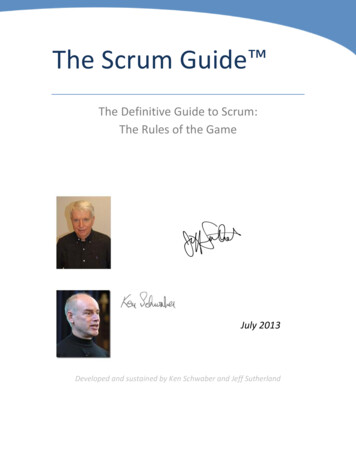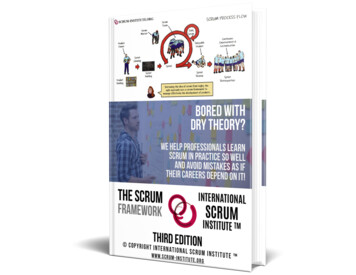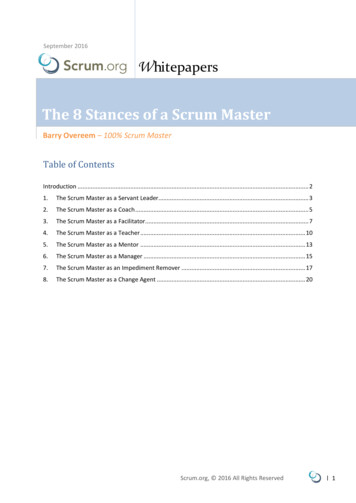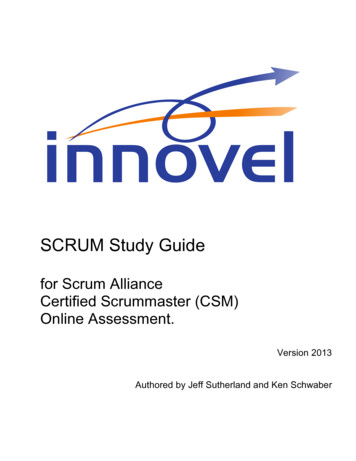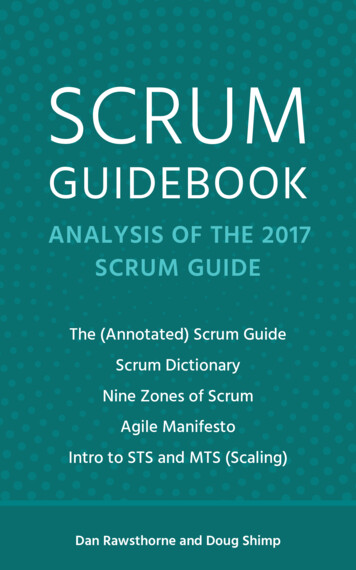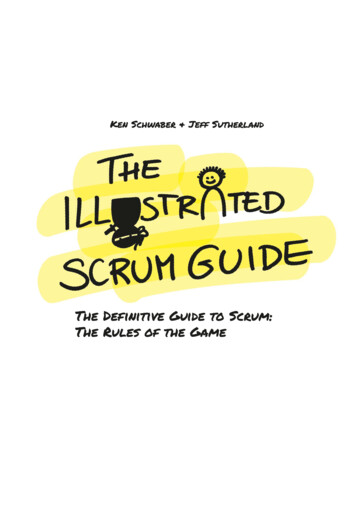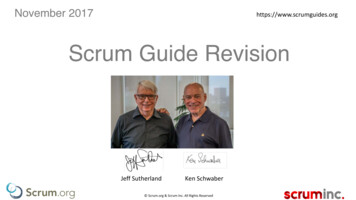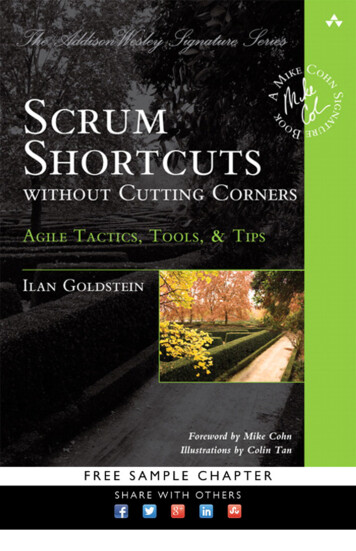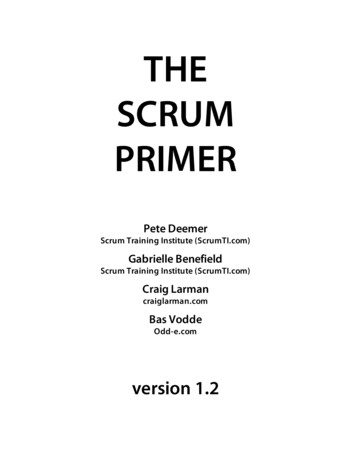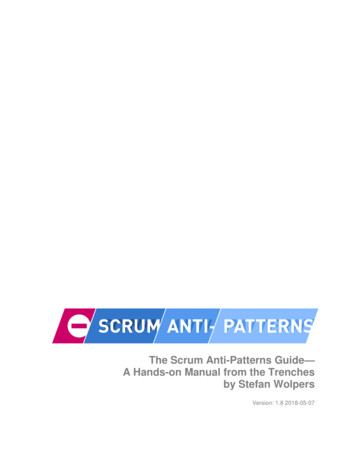
Transcription
The Scrum Anti-Patterns Guide—A Hands-on Manual from the Trenchesby Stefan WolpersVersion: 1.8 2018-05-07
The Scrum Anti-Patterns GuideInhaltsverzeichnisPREFACE4SCRUM CEREMONY ANTI-PATTERNS517 STAND-UP ANTI-PATTERNSTHE DAILY SCRUMSTAND-UP ANTI-PATTERNS – FROM DYSFUNCTIONAL SCRUM TEAMS TO ORGANIZATIONAL FAILURESCONCLUSION28 PRODUCT BACKLOG AND REFINEMENT ANTI-PATTERNSTHE PRODUCT BACKLOGTHE PRODUCT BACKLOG REFINEMENT ACCORDING TO THE SCRUM GUIDEA TYPICAL PRODUCT BACKLOG REFINEMENT PROCESSCOMMON PRODUCT BACKLOG (REFINEMENT) ANTI-PATTERNSCONCLUSION:19 SPRINT PLANNING ANTI-PATTERNSTHE SPRINT PLANNINGTHE PURPOSE OF THE SPRINT PLANNINGSPRINT PLANNING ANTI-PATTERNSCONCLUSION27 SPRINT ANTI-PATTERNSTHE SPRINTSPRINT ANTI-PATTERNSCONCLUSION14 SPRINT REVIEW ANTI-PATTERNSTHE SPRINT REVIEWTHE PURPOSE OF SCRUM’S SPRINT REVIEWSPRINT REVIEW ANTI-PATTERNSCONCLUSION21 SPRINT RETROSPECTIVE ANTI-PATTERNS IMPEDING SCRUM TEAMSINTRODUCTIONSPRINT RETROSPECTIVE 25262626272930303034SCRUM ROLE ANTI-PATTERNS35PRODUCT OWNER ANTI-PATTERNSPRODUCT BACKLOG AND REFINEMENTSPRINT PLANNING ANTI-PATTERNSSPRINT ANTI-PATTERNSSTAND-UPSPRINT REVIEW ANTI-PATTERNSCONCLUSION:SCRUM MASTER ANTI-PATTERNSINTRODUCTIONTHE SCRUM MASTER ACCORDING TO THE SCRUM GUIDEPOSSIBLE REASONS WHY SCRUM MASTERS LEAVE THE AGILE PATH3535373839394041414142Stefan Wolpers: The Scrum Anti-Patterns GuidePage 2 of 69
The Scrum Anti-Patterns GuideTHE SCRUM MASTER AS AGILE MANAGERSCRUM MASTER ANTI-PATTERNS BY SCRUM CEREMONYTHE CONCLUSIONSCRUM MASTER ANTI-PATTERNS DERIVED FROM JOB ADSANALYZING A JOB ADVERTISEMENT FOR A SCRUM MASTER OR AGILE COACH POSITIONSCRUM MASTER ANTI-PATTERNS FROM JOB ADS IN 22 EXAMPLESCONCLUSION—SCRUM MASTER ANTI-PATTERNS FROM JOB ADSSCRUM STAKEHOLDER ANTI-PATTERNSTHE SCRUM STAKEHOLDER AND ORGANIZATIONAL EXCELLENCE IN LEGACY ORGANIZATIONSA LIST OF SCRUM STAKEHOLDER ANTI-PATTERNSSCRUM STAKEHOLDER ANTI-PATTERNS — CONCLUSION4345484949505354545661HOW TO DETECT SCRUM ANTI-PATTERNS62USE BURN-DOWN CHARTS TO DISCOVER SCRUM ANTI-PATTERNSINTRODUCTIONSCRUM ANTI-PATTERNS VISUALIZED BY BURN-DOWN CHARTSTHE CONCLUSION62626368ABOUT THE AUTHOR69Stefan Wolpers: The Scrum Anti-Patterns GuidePage 3 of 69
The Scrum Anti-Patterns GuidePrefaceWelcome to my hands-on guide on scrum anti-patterns, detailing over 160 anti-patternsthat you might observe in practice.Please note that I will not be able to automatically provide you with new versions of thisebook if you unsubscribe from the Food for Agile Thought newsletter. In doing so, you alsodelete your email address from the list of readers of this ebook.Thank you for your understanding!Best,StefanStefan Wolpers: The Scrum Anti-Patterns GuidePage 4 of 69
The Scrum Anti-Patterns GuideScrum Ceremony Anti-Patterns17 Stand-up Anti-PatternsThe Daily ScrumThe daily stand-up is the ceremony with the highest anti-pattern density among all scrumceremonies. Learn more about the stand-up anti-patterns that threaten to derail your agiletransition.Stand-up Anti-Patterns – From Dysfunctional Scrum Teams to OrganizationalFailuresTypically, a good scrum team needs about five to ten minutes for a stand-up. Given thisshort period, it is interesting to observe that the daily stand-up is the scrum ceremony withthe highest potential anti-pattern density. The anti-patterns range from behaviors driven bydysfunctional teams to apparent failures at an organizational level.My favorite stand-up anti-patterns are as follows:1. No routine: The stand-up does not happen at the same time and the same placeevery day. (While routine has the potential to ruin every retrospective, it is helpful inthe context of stand-ups. Think of it like a spontaneous drill: don’t put too muchthought into the stand-up, just do it. Skipping stand-ups can turn out to be a slipperyslope. And skipping may only be acceptable the day after the sprint planning.However, please keep in mind that every team member can veto skipping the standup.))2. Status report: The stand-up is a status report meeting, and team members arewaiting in line to “report” progress to the scrum master, the product owner, ormaybe even a stakeholder.3. Ticket numbers only: Updates are generic with little or no value to others.(“Yesterday, I worked on X-123. Today, I will work on X-129.”)4. Problem solving: Discussions are triggered to solve problems, instead of parkingthose so they can be addressed after the stand-up.5. Planning meeting: The team hijacks the stand-up to discuss new requirements, torefine user stories, or to have a sort of (sprint) planning meeting.Stefan Wolpers: The Scrum Anti-Patterns GuidePage 5 of 69
The Scrum Anti-Patterns Guide6. No red dots: A team member experiences difficulties in accomplishing an issue overseveral consecutive days, and nobody is offering help. (This a sign that that peopleeither do not trust each other, or that the utilization of the team is maximized.)7. Monologs: Team members violate the time-boxing, starting monologues. (60 to 90seconds per team member should be more than enough time on air.)8. Statler and Waldorf: A few team members are commenting every issue. (Usually,this is not just a waste of time, but also patronizing as well as annoying.)9. Disrespect I: Other team members are talking while someone is sharing his or herprogress with the team. (Similarly irritating is the need to use speak tokens amongadults to avoid this behavior.)10. Assignments: The product owner – or scrum master – assigns tasks directly to teammembers.11. Cluelessness: Team members are not prepared for the stand-up. (“I was doing somestuff but I cannot remember what. Was important, though.”)12. Let’s start the shift: The stand-up acts as a kind of artificial factory siren to start thenext shift. (This is a common Taylorism artifact where trust in the team is missing.)13. Disrespect II: Team members are late to the stand-up. (Note: if the time for thestand-up was not chosen by the team it otherwise indicates distrust on themanagement side.)14. Excessive feedback: Team members criticize other team members right awaysparking a discussion instead of taking their critique outside the stand-up.15. Overcrowded: Stand-ups are ineffective due to the large number of activeparticipants.16. Talkative chickens: “Chickens” actively participate in the stand-up. (I think it isgenerally acceptable if stakeholder ask a question during the stand-up. However,they are otherwise supposed to merely listen in.)17. Anti-agile: Line managers are attending stands-up to gather “performance data” onindividual team members. (This behavior is defying the very purpose of selforganizing teams.)Depending on the context, it could also be an anti-pattern if the product owner – or evenanother stakeholder – is introducing new tickets to the current sprint during the stand-up.This behavior may be acceptable for priority one bugs. (Although the team should be awareStefan Wolpers: The Scrum Anti-Patterns GuidePage 6 of 69
The Scrum Anti-Patterns Guideof those before the stand-up.) However, it is an unacceptable behavior – and thus an antipattern – for changing priorities on the fly in the middle of a sprint.Lastly, some teams like to have stand-ups in Slack, particularly those that are not co-located.Again, depending on the context, this does not need to manifest an anti-pattern per se. I waseven working with a co-located team that used Slack as their preferred way of having astand-up. It worked.ConclusionA lot of agile practitioners tend to consider stand-ups to be a candidate for waste. However,from a scrum master or agile coach perspective stand-ups offer the highest yield of antipatterns – given the effort is so small by comparison to other ceremonies.Stefan Wolpers: The Scrum Anti-Patterns GuidePage 7 of 69
The Scrum Anti-Patterns Guide28 Product Backlog and Refinement Anti-PatternsThe Product BacklogScrum is a practical framework to build products, provided you identified in advance whatto build. But even after a successful product discovery phase, you may struggle to make theright thing in the right way if your product backlog is not up to the job.The following article points at the most common product backlog anti-patterns – includingthe product backlog refinement process – that limit your team’s success.The Product Backlog Refinement According to the Scrum GuideFirst of all, let’s have a look at the current issue of the Scrum Guide on the product backlogrefinement:“Product Backlog refinement is the act of adding detail, estimates, and order to items in the ProductBacklog. This is an ongoing process in which the Product Owner and the Development Teamcollaborate on the details of Product Backlog items. During Product Backlog refinement, items arereviewed and revised. The Scrum Team decides how and when refinement is done. Refinement usuallyconsumes no more than 10% of the capacity of the Development Team. However, Product Backlogitems can be updated at any time by the Product Owner or at the Product Owner’s discretion.Higher ordered Product Backlog items are usually clearer and more detailed than lower ordered ones.More precise estimates are made based on the greater clarity and increased detail; the lower the order,the less detail. Product Backlog items that will occupy the Development Team for the upcoming Sprintare refined so that any one item can reasonably be “Done” within the Sprint time-box. Product Backlogitems that can be “Done” by the Development Team within one Sprint are deemed “Ready” for selectionin a Sprint Planning. Product Backlog items usually acquire this degree of transparency through theabove-described refining activities.The Development Team is responsible for all estimates. The Product Owner may influence theDevelopment Team by helping it understand and select trade-offs, but the people who will perform thework make the final estimate.”Source & Copyright: 2016 Scrum.Org and ScrumInc1.A Typical Product Backlog Refinement ProcessBased on the Scrum Guide, a typical process looks as follows:Offered for license under the Attribution Share-Alike license of Creative Commons, accessibleat lcode and also described in summary format efan Wolpers: The Scrum Anti-Patterns GuidePage 8 of 69
The Scrum Anti-Patterns Guide1.The product owner prioritizes the backlog in advance, so it reflects the bestpossible use of the development team’s resources:a.The product owner creates and pre-populates the two upcoming sprintswith user stories, using the team’s project management software (or aspreadsheet or any other organizational tool the team applies).b.The product owner maintains this pattern continuously.c.The product owner also adds new user stories that he or she may haveidentified since the previous refinement session.The product owner and the development team are jointly working on user stories:a.The product owner provides the answer to the ‘why’ question (businesspurpose),b.The team answers the ‘how’ question (technical implementation),c.And both collaborate on the ‘what’ question: what scope is necessary toachieve the desired purpose?The whole team agrees to time-box discussions. A typical time-box per user storywould be around five minutes on average per cycle.The product owner provides the acceptance criteria to user stories.The development team defines what is required to consider a user story to beready for becoming a sprint backlog item.The product owner clarifies questions of the team or invites subject matterexperts to refinement sessions who can answer the team’s questions.Consecutive refinement cycles last until each user story meets the definition ofready, or is no longer pursued.Lastly, the team may estimate the available user stories that meet the “definitionof ready” criteria. The product owner can now choose from those user stories tobecome part of an upcoming sprint.2.3.4.5.6.7.8.Common Product Backlog (Refinement) Anti-PatternsDespite being a relatively straightforward, the process of creating and refining a productbacklog often suffers from various anti-patterns. I have identified four different categories:General Product Backlog Anti-Patterns Prioritization by proxy: A single stakeholder or a committee of stakeholderprioritizes the product backlog. (The strength of Scrum is building on the strongposition of the product owner. The product owner is the only persons to decidewhat tasks become product backlog items. Hence, the product owner alsodecides on the priority. Take away that empowerment, and Scrum turns into apretty robust waterfall 2.0 process.)Stefan Wolpers: The Scrum Anti-Patterns GuidePage 9 of 69
The Scrum Anti-Patterns Guide 100% in advance: The scrum team creates a product backlog covering thecomplete project or product upfront because the scope of the release is limited.(Question: how can you be sure to know today what to deliver in six months fromnow?) Over-sized: The product backlog contains more items than the scrum team candeliver within three to four sprints. (This way the product owner creates wasteby hoarding issues that might never materialize.) Outdated issues: The product backlog contains items that haven’t been touchedfor six to eight weeks or more. (That is typically the length of two to four sprints.If the product owner is hoarding backlog items, the risk emerges that older itemsbecome outdated, thus rendering previously invested work of the scrum teamobsolete.) Everything is estimated: All user stories of the product backlog are detailed andestimated. (That is too much upfront work and bears the risk of misallocating thescrum team’s time.) Component-based items: The product backlog items are sliced horizontallybased on components instead of vertically based on end-to-end features. (Thismay be either caused by your organizational structure. Then move to crossfunctional teams to improve the team’s ability to deliver. Otherwise, the team –and the product owner – need a workshop on writing user stories.) Missing acceptance criteria: There are user stories in the product backlogwithout acceptance criteria. (It is not necessary to have acceptance criteria at thebeginning the refinement cycle although they would make the task much easier.In the end, however, all user stories need to meet the definition of ready standard,and acceptance criteria are a part of that definition.) No more than a title: The product backlog contains user stories that comprise oflittle more than a title. (See above.) Issues too detailed: There are user stories with an extensive list of acceptancecriteria. (This is the other extreme: the product owner covers each edge casewithout negotiating with the team. Typically, three to five acceptance criteria aremore than sufficient.) Neither themes nor epics: The product backlog is not structured by themes orepics. (This makes it hard to align individual items with the “big picture” of theorganization. The product backlog is not supposed to be an assortment ofStefan Wolpers: The Scrum Anti-Patterns GuidePage 10 of 69
The Scrum Anti-Patterns Guideisolated tasks or a large to-do-list.) No research: The product backlog contains few to no spikes. (This oftencorrelates with a team that is spending too much time on discussing prospectiveproblems, instead of researching them with a spike as a part of an iterative userstory creation process.)Product Backlog Anti-Patterns at Portfolio and Product Roadmap Level Roadmap? The product backlog is not reflecting the roadmap. (The productbacklog is supposed to be detailed only for the first two or three sprints. Beyondthat point, the product backlog should rather focus on themes and epics from theproduct roadmap. If those are not available, the product backlog is likely togranular.) Annual roadmaps: The organization’s portfolio plan, as well as the release planor product roadmap, are created once a year in advance. (If the product backlogstays aligned to these plans, it introduces waterfall planning through thebackdoor. Agile planning is always “continuous”. At the portfolio level, the planneeds to be revised be least every three months.) Roadmaps kept secret: The portfolio planning and the release plan or productroadmap are not visible to everybody. (If you do not know where you are goingany road will get you there. This information is crucial for any scrum team andneeds to be available to everybody at any time. ) China in your hands: The portfolio planning and the release plan or the productroadmap are not considered achievable and believable. (If this is reflected in theproduct backlog, working on user stories will probably be a waste.)Product Backlog Anti-Patterns of the Product Owner Storage for ideas: The product owner is using the product backlog as arepository of ideas and requirements. (This practice is clogging the productbacklog, may lead to a cognitive overload and makes alignment with the ‘bigpicture’ at portfolio management and roadmap planning level very tough.) Part-time PO: The product owner is not working daily on the product backlog.(The product backlog needs to represent at any given time the best use of thedevelopment team’s resources. Updating it once a week before the nextrefinement session does not suffice to meet this requirement.)Stefan Wolpers: The Scrum Anti-Patterns GuidePage 11 of 69
The Scrum Anti-Patterns Guide Copy & paste PO: The product owner creates user stories by breaking downrequirement documents received from stakeholders into smaller chunks. (Thatscenario helped to coin the nickname “ticket monkey” for the product owner.Remember: user story creation is a team exercise.) Dominant PO: The product owner creates user stories by providing not just the‘why’ but also the ‘how’, and the ‘what’. (The team answers the ‘how’ question –the technical implementation –, and both the team and the PO collaborate on the‘what’ question: what scope is necessary to achieve the desired purpose.) INVEST? The product owner is not applying the INVEST principle by Bill Wake touser stories. Issues too detailed: The product owner invests too much time upfront in userstories making them too detailed. (If a user story looks complete, the teammembers might not see the necessity to get involved in a further refinement. Thisway a “fat” user story reduces the engagement level of the team, compromisingthe creation of a shared understanding. By the way, this didn’t happen back inthe days when we used index cards given their physical limitation.) What team? The product owner is not involving the entire scrum team in therefinement process and instead is relying on just the “lead engineer” (or anyother member of the team independently of the others). ‘I know it all’ PO: The product owner does not involve stakeholders or subjectmatter experts in the refinement process. (A product owner who believes to beeither omniscient or a communication gateway is a risk to the Scrum team’ssuccess.)Product Backlog Anti-Patterns of the Development Team Submissive team: The development team submissively follows the demands ofthe product owner. (Challenging the product owner whether his or her selectionof issues is the best use of the development team’s time is the noblest obligationof every team member: why shall we do this?) What technical debt? The development team is not demanding adequateresources to tackle technical debt and bugs. (The rule of thumb is that 25% ofresources are allocated every sprint to fixings bugs and refactor the code base.) No slack: The development team is not demanding 20% slack time from theproduct owner. (This is overlapping with the sprint planning and the team’scommitment. However, it cannot be addressed early enough. If a team’s capacityStefan Wolpers: The Scrum Anti-Patterns GuidePage 12 of 69
The Scrum Anti-Patterns Guideis always utilized at 100 %, its performance will decrease over time. Everyonewill focus on getting his or her tasks done. There will be less time to supportteammates or to pair. Small issues will no longer be addressed immediately. Andultimately, the ‘I am busy’ attitude will reduce the generation of a sharedunderstanding among all team members why they do what they are doing.)Product Backlog Anti-Patterns of the Scrum Team No time for refinement: The team does not have enough refinement sessions,resulting in a low-quality backlog. (The Scrum Guide advises spending up to 10%of the Scrum team’s time on the product backlog refinement. Which is a soundbusiness decision: Nothing is more expensive than a feature that is not deliveringany value.) Too much refinement: The team has too many refinement sessions, resulting ina too detailed backlog. (Too much refinement isn’t healthy either.) No DoR: The scrum team has not created a ‘definition of ready’ that productbacklog items need to match before becoming selectable for a sprint. (A simplechecklist like the ‘definition of ready’ can significantly improve the scrum team’swork. It will increase the quality of both the resulting user stories as well as thegeneral way of working as a team.)Conclusion:Even in the case, you have successfully identified what to build next, your product backlog,as well as its refinement process, will likely provide room for improvement. Just take it tothe team.What product backlog and refinement anti-patterns are missing? Please share with us in thecomments.Stefan Wolpers: The Scrum Anti-Patterns GuidePage 13 of 69
The Scrum Anti-Patterns Guide19 Sprint Planning Anti-PatternsThe Sprint PlanningScrum’s sprint planning is a simple ceremony. Invest upfront during the product backlogrefinement, and you will keep it productive. Avoiding the following 19 sprint planning antipatterns will help, too.The Purpose of the Sprint PlanningThe purpose of Scrum’s sprint planning is to align the development team and the productowner. Both need to agree on the shippable product increment of the next sprint. The ideais that the development team’s commitment reflects the product owner’s sprint goal. Also,the team needs to come up with a plan on how to accomplish its commitment. (Or forecast ifyou prefer that term.)If the scrum team has been successfully using product backlog refinements in the past thesprint planning part 1 will be short. The development team and the product owner willStefan Wolpers: The Scrum Anti-Patterns GuidePage 14 of 69
The Scrum Anti-Patterns Guideadjust the discussed scope of the upcoming sprint to the available capacity. Maybe,someone from development team will not be available next sprint. So, one or two tasks willhave to go back to the product backlog.Or a valuable new task appeared overnight, and the product owner wants this task tobecome a part of the next sprint backlog. Consequently, some other user story needs to goback to the product backlog. A good team can handle that in five to ten minutes beforemoving on to sprint planning part 2. During sprint planning II the team breaks down thefirst set of sprint backlog items into subtasks.Sprint Planning Anti-PatternsThere are three categories of sprint planning anti-patterns. They concern the developmentteam, the product owner, and the scrum team.Sprint Planning Anti-Patterns of the Development Team Any absentees? The team members do not determine their availability at thebeginning of the sprint planning. (Good luck with making a commitment in thissituation.) Capacity? The development team overestimates its capacity and takes on too manytasks. (The development team should instead take everything into account thatmight affect its ability to deliver. The list of those issues is long: public holidays, newteam members, and those on vacation leave, team members quitting, team memberson sick leave, corporate overhead, scrum ceremonies and other meetings to name afew.) Ignoring technical debt: The development team is not demanding adequatecapacity to tackle technical debt and bugs during the sprint. (The rule of thumb isthat 25% of resources are allocated every sprint to fix bugs and refactor the codebase. If the product owner ignores this practice, and the development team acceptsthis violation the scrum team will find itself in a downward spiral. Its future productdelivery capability will decrease.) No slack: The development team is not demanding 20% slack time from the productowner. (If a team’s capacity is always over-utilized, its performance will decreaseover time. This will particularly happen in an organization with a volatile dailybusiness. As a consequence, everyone will focus on getting his or her tasks done.There will be less time to support teammates or to pair. The team will no longeraddress smaller or urgent issues promptly. Individual team members will becomebottlenecks, which might seriously impede the flow within the team. Lastly, the ‘I ambusy’ attitude will reduce the generation of a shared understanding among all teamStefan Wolpers: The Scrum Anti-Patterns GuidePage 15 of 69
The Scrum Anti-Patterns Guidemembers. Overutilization will always push the individual team member to focus onhis or her output. On the other side, slack time will allow the scrum team to actcollaboratively and focus on the outcome.) Planning too detailed: During sprint planning II, the development team plans everysingle subtask of the upcoming sprint in advance. (Don’t become too granular. Twothirds of the sub-tasks are more than sufficient, the rest will follow naturally duringthe sprint. Doing too much planning upfront might result in waste.) Too much estimating: The development team estimates sub-tasks. (That looks likeaccounting for the sake of accounting to me. Don’t waste your time on that.) Too little planning: The development team is skipping the sprint planning IIaltogether. (Skipping the sprint planning II is unfortunate, as it is also a goodsituation to talk about how to spread knowledge within the development team. Forexample, the team should think about who will be pairing with whom on what task.The sprint planning II is also a well-suited to consider how to reduce technical debt.) Team leads? The development team does not come up with a plan to deliver on itscommitment collaboratively. Instead, a ‘team lead’ assigns tasks to individual teammembers. (I know that senior developers do not like the idea, but there is no ‘teamlead’ in a scrum team. Read More: Why Engineers Despise Agile).Sprint Planning Anti-Patterns of the Product Owner What are we fighting for? The product owner cannot provide a sprint goal, or thechosen sprint goal is flawed. (An original sprint goal answers the “What are wefighting for?” question. It is a negotiation between the product owner and thedevelopment team. It is focused and measurable, as sprint goal and teamcommitment go hand in hand. Lastly, the sprint goal is a useful calibration for theupcoming sprint.) Calling Kanban ‘Scrum’: The sprint backlog resembles a random assortment oftasks, and no sprint goal is defined. (If this is the natural way of finishing your sprintplanning I, you probably have outlived the usefulness of Scrum as a productdevelopment framework. Depending on the maturity of your product, Kanban mayprove to be a better solution. Otherwise, the randomness may signal a weak productowner who listens too much to stakeholders instead of prioritizing the productbacklog appropriately.) Unfinished business: Unfinished user stories and other tasks from the last sprintspill over into the new sprint without any discussion. (There might be good reasonsfor that, for example, a task’s value has not changed. It should not be an automatism,Stefan Wolpers: The Scrum Anti-Patterns GuidePage 16 of 69
The Scrum Anti-Patterns Guidethough, remember the sunk cost fallacy.) Last minute changes: The product owner tries to squeeze in some last-minute userstories that do not meet the definition of ready. (Principally, it is the prerogative ofthe product owner to make such kind of changes to ensure that the developmentteam is working only on the most valuable user stories at any given time. However, ifthe scrum team is otherwise practicing product backlog refinement sessionsregularly, these occurrences should be a rare exception. If those happen frequently,it indicates that the product owner needs help with prioritization and teamcommunication. Or the product owner needs support to say ‘no’ more often tostakeholders.) Output focus: The product owner pushes the development team to take on moretasks than it could realistically handle. Probably, the product owner is referring toformer team metrics such as velocity to support his or her desire. (This would be anopportunity for the candidate to step in and address the issue.)Sprint Planning Anti-Patterns of the Scrum Team Irregular sprint lengths: The scrum team has variable sprint cadences. Forexample, tasks are not sized to fit into the regular sprint length. Instead, the sprintlength is adapted to the size of the tasks. (It is quite common to extend the sprintlength at the end of the year when most of the team member are on holiday.However, there is no reason to deviate from the regular cadence during the rest ofthe year. Instead of changing the sprint length, the scrum team should invest moreeffort into sizing epics and user stories in the right way.) Over-commitment: The scrum team regularly takes on way too many tasks andmoves unfinished work simply to the next sprint. (If two or three items spill over tothe next sprint, so be it. If regularly 30-40 percent of the original commitment is notdelivered during the sprint the scrum team may have created a kind of ‘time-boxedKanban.’ Maybe, this is the right moment to ask the scrum team whether moving toKanban might be an alternative.) Stage-gate by DoR: The definition of ready is handled in a dogmatic way thuscreating a stage-gate-like approval process. (That is an interesting topic for adiscussion among the team members. For example, should a va
May 07, 2018 · stefan wolpers: the scrum anti-patterns guide page 3 of 69 the scrum anti-patterns guide the scrum master as agile manager 43 scrum master anti-patterns by scrum ceremony 45 the conclusion 48 scrum master anti-patterns derived from job ads 49 analyzing a job advertisement for a scrum master or agile coach
